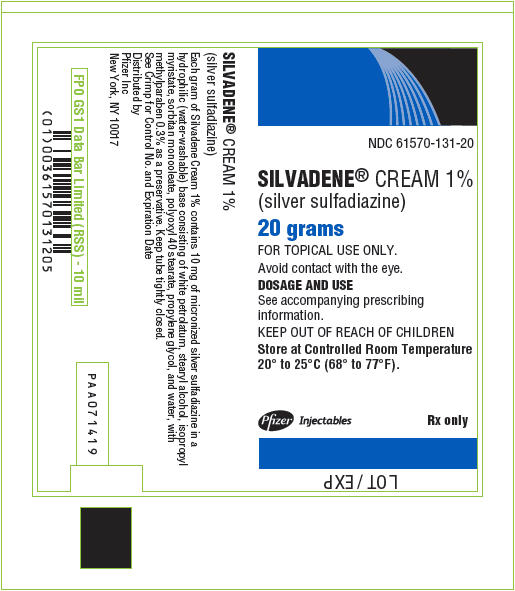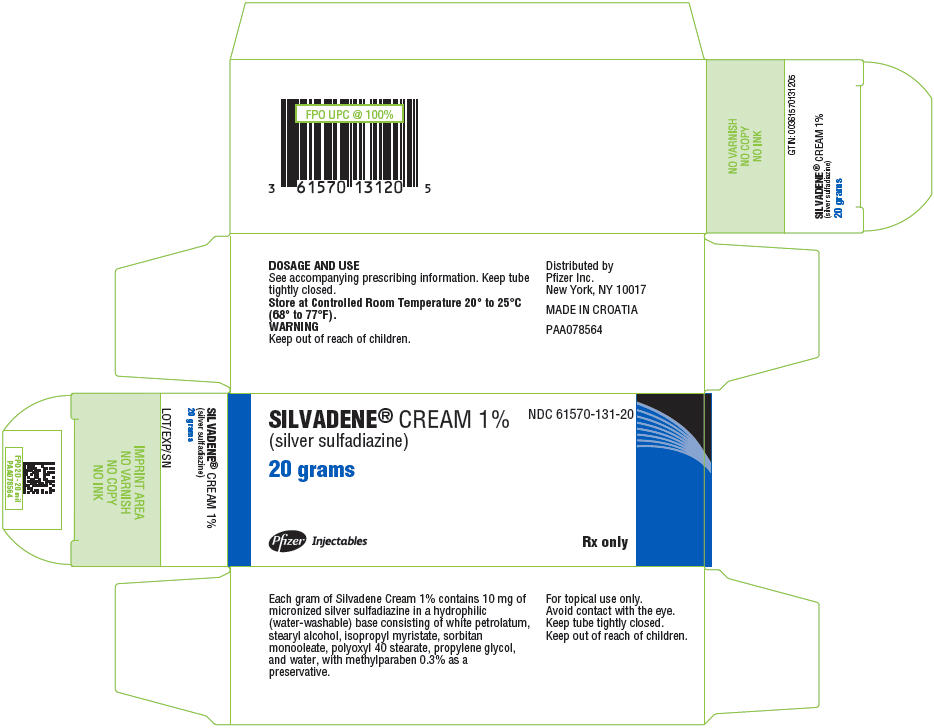SILVADENE- silver sulfadiazine cream
SILVADENE by
Drug Labeling and Warnings
SILVADENE by is a Prescription medication manufactured, distributed, or labeled by Pfizer Laboratories Div Pfizer Inc, Pharmacia and Upjohn Company LLC. Drug facts, warnings, and ingredients follow.
Drug Details [pdf]
-
DESCRIPTION
SILVADENE Cream 1% is a soft, white, water-miscible cream containing the antimicrobial agent silver sulfadiazine in micronized form, which has the following structural formula:

Each gram of SILVADENE Cream 1% contains 10 mg of micronized silver sulfadiazine. The cream vehicle consists of white petrolatum, stearyl alcohol, isopropyl myristate, sorbitan monooleate, polyoxyl 40 stearate, propylene glycol, and water, with methylparaben 0.3% as a preservative. SILVADENE Cream 1% (silver sulfadiazine) spreads easily and can be washed off readily with water.
-
CLINICAL PHARMACOLOGY
Silver sulfadiazine has broad antimicrobial activity. It is bactericidal for many gram-negative and gram-positive bacteria as well as being effective against yeast. Results from in vitro testing are listed below.
Sufficient data have been obtained to demonstrate that silver sulfadiazine will inhibit bacteria that are resistant to other antimicrobial agents and that the compound is superior to sulfadiazine.
Studies utilizing radioactive micronized silver sulfadiazine, electron microscopy, and biochemical techniques have revealed that the mechanism of action of silver sulfadiazine on bacteria differs from silver nitrate and sodium sulfadiazine. Silver sulfadiazine acts only on the cell membrane and cell wall to produce its bactericidal effect.
Results of In Vitro Testing with SILVADENE® Cream 1% (silver sulfadiazine) Concentration of Silver Sulfadiazine Number of Sensitive Strains/Total Number of Strains Tested Genus & Species 50 μg/mL 100 μg/mL Pseudomonas aeruginosa 130/130 130/130 Xanthomonas (Pseudomonas) maltophilia 7/7 7/7 Enterobacter species 48/50 50/50 Enterobacter cloacae 24/24 24/24 Klebsiella species 53/54 54/54 Escherichia coli 63/63 63/63 Serratia species 27/28 28/28 Proteus mirabilis 53/53 53/53 Morganella morganii 10/10 10/10 Providencia rettgeri 2/2 2/2 Providencia species 1/1 1/1 Proteus vulgaris 2/2 2/2 Citrobacter species 10/10 10/10 Acinetobacter calcoaceticus 10/11 11/11 Staphylococcus aureus 100/101 100/101 Staphylococcus epidermidis 51/51 51/51 β-Hemolytic Streptococcus 4/4 4/4 Enterococcus species 52/53 53/53 Corynebacterium- diphtheriae 2/2 2/2 Clostridium perfringens 0/2 2/2 Candida albicans 43/50 50/50 Silver sulfadiazine is not a carbonic anhydrase inhibitor and may be useful in situations where such agents are contraindicated.
- INDICATIONS AND USAGE
-
CONTRAINDICATIONS
SILVADENE Cream 1% (silver sulfadiazine) is contraindicated in patients who are hypersensitive to silver sulfadiazine or any of the other ingredients in the preparation.
Because sulfonamide therapy is known to increase the possibility of kernicterus, SILVADENE Cream 1% should not be used on pregnant women approaching or at term, on premature infants, or on newborn infants during the first 2 months of life.
-
WARNINGS
Absorption of silver sulfadiazine varies depending upon the percent of body surface area and the extent of the tissue damage. Although few have been reported, it is possible that any adverse reaction associated with sulfonamides may occur. Some of the reactions, which have been associated with sulfonamides, are as follows: blood dyscrasias including agranulocytosis, aplastic anemia, thrombocytopenia, leukopenia, and hemolytic anemia; dermatologic and allergic reactions, including life-threatening cutaneous reactions [Stevens-Johnson syndrome (SJS), toxic epidermal necrolysis (TEN) and exfoliative dermatitis]; gastrointestinal reactions; hepatitis and hepatocellular necrosis; CNS reactions; and toxic nephrosis.
There is potential cross-sensitivity between silver sulfadiazine and other sulfonamides. If allergic reactions attributable to treatment with silver sulfadiazine occur, continuation of therapy must be weighed against the potential hazards of the particular allergic reaction.
Fungal proliferation in and below the eschar may occur. However, the incidence of clinically reported fungal superinfection is low.
The use of SILVADENE Cream 1% (silver sulfadiazine) in some cases of glucose-6-phosphate dehydrogenase-deficient individuals may be hazardous, as hemolysis may occur.
-
PRECAUTIONS
General
If hepatic and renal functions become impaired and elimination of drug decreases, accumulation may occur and discontinuation of SILVADENE Cream 1% (silver sulfadiazine) should be weighed against the therapeutic benefit being achieved.
In considering the use of topical proteolytic enzymes in conjunction with SILVADENE Cream 1%, the possibility should be noted that silver may inactivate such enzymes.
SILVADENE Cream 1% (silver sulfadiazine) is for topical use only. Avoid contact of SILVADENE Cream 1% (silver sulfadiazine) with the eye.
Laboratory Tests
In the treatment of burn wounds involving extensive areas of the body, the serum sulfa concentrations may approach adult therapeutic levels (8 mg% to 12 mg%). Therefore, in these patients it would be advisable to monitor serum sulfa concentrations. Renal function should be carefully monitored and the urine should be checked for sulfa crystals. Absorption of the propylene glycol vehicle has been reported to affect serum osmolality, which may affect the interpretation of laboratory tests.
Carcinogenesis, Mutagenesis, Impairment of Fertility
Long-term dermal toxicity studies of 24 months' duration in rats and 18 months' in mice with concentrations of silver sulfadiazine three to ten times the concentration in SILVADENE Cream 1% revealed no evidence of carcinogenicity.
Pregnancy
Teratogenic Effects.
A reproductive study has been performed in rabbits at doses up to three to ten times the concentration of silver sulfadiazine in SILVADENE Cream 1% and has revealed no evidence of harm to the fetus due to silver sulfadiazine. There are, however, no adequate and well-controlled studies in pregnant women. Because animal reproduction studies are not always predictive of human response, this drug should be used during pregnancy only if clearly justified, especially in pregnant women approaching or at term. (See CONTRAINDICATIONS.)
Nursing Mothers
It is not known whether silver sulfadiazine is excreted in human milk. However, sulfonamides are known to be excreted in human milk, and all sulfonamide derivatives are known to increase the possibility of kernicterus. Because of the possibility for serious adverse reactions in nursing infants from sulfonamides, a decision should be made whether to discontinue nursing or to discontinue the drug, taking into account the importance of the drug to the mother.
Geriatric Use
Of the total number of subjects in clinical studies of Silvadene Cream 1%, seven percent were 65 years of age and over. No overall differences in safety or effectiveness were observed between these subjects and younger subjects, and other reported clinical experience has not identified differences in responses between the elderly and younger patients, but greater sensitivity of some older individuals cannot be ruled out.
Pediatric Use
Safety and effectiveness in pediatric patients have not been established. (See CONTRAINDICATIONS.)
-
ADVERSE REACTIONS
Several cases of transient leukopenia have been reported in patients receiving silver sulfadiazine therapy.1,2,3 Leukopenia associated with silver sulfadiazine administration is primarily characterized by decreased neutrophil count. Maximal white blood cell depression occurs within 2 to 4 days of initiation of therapy. Rebound to normal leukocyte levels follows onset within 2 to 3 days. Recovery is not influenced by continuation of silver sulfadiazine therapy. An increased incidence of leukopenia has been reported in patients treated concurrently with cimetidine.
Other infrequently occurring events include skin necrosis, erythema multiforme, skin discoloration, burning sensation, rashes, and interstitial nephritis.
Reduction in bacterial growth after application of topical antibacterial agents has been reported to permit spontaneous healing of deep partial-thickness burns by preventing conversion of the partial thickness to full thickness by sepsis. However, reduction in bacterial colonization has caused delayed separation, in some cases necessitating escharotomy in order to prevent contracture.
-
DOSAGE AND ADMINISTRATION
Prompt institution of appropriate regimens for care of the burned patient is of prime importance and includes the control of shock and pain. The burn wounds are then cleansed and debrided, and SILVADENE Cream 1% (silver sulfadiazine) is applied under sterile conditions. The burn areas should be covered with SILVADENE Cream 1% at all times. The cream should be applied once to twice daily to a thickness of approximately 1/16 inch. Whenever necessary, the cream should be reapplied to any areas from which it has been removed by patient activity. Administration may be accomplished in minimal time because dressings are not required. However, if individual patient requirements make dressings necessary, they may be used.
Reapply immediately after hydrotherapy.
Treatment with SILVADENE Cream 1% should be continued until satisfactory healing has occurred, or until the burn site is ready for grafting. The drug should not be withdrawn from the therapeutic regimen while there remains the possibility of infection except if a significant adverse reaction occurs.
-
HOW SUPPLIED
SILVADENE Cream 1% (silver sulfadiazine) is available in jars containing 50 g (NDC 61570-131-50), 400 g (NDC 61570-131-40), and 1000 g (NDC 61570-131-98) and tubes containing 20 g (NDC 61570-131-20) , 25 g (NDC 61570-131-25), 50 g (NDC 61570-131-55) and 85 g (NDC 61570-131-85).
Store at Controlled Room Temperature 20° to 25°C (68° to 77°F).
-
REFERENCES
- Caffee F, Bingham H. Leukopenia and silver sulfadiazine. J Trauma. 1982;22: 586–587.
- Jarret F, Ellerbe S, Demling R. Acute leukopenia during topical burn therapy with silver sulfadiazine. Amer J Surg. 1978;135:818–819.
- Kiker RG, Carvajal HF, Micak RP, Larson DL. A controlled study of the effects of silver sulfadiazine on white blood cell counts in burned children. J Trauma. 1977; 17:835–836.
This product's label may have been updated. For current full prescribing information, please visit www.pfizer.com.

LAB-0647-6.0
September 2016
-
PRINCIPAL DISPLAY PANEL - 20 gram Tube Label
NDC: 61570-131-20
SILVADENE® CREAM 1%
(silver sulfadiazine)20 grams
FOR TOPICAL USE ONLY.
Avoid contact with the eye.
DOSAGE AND USE
See accompanying prescribing
information.KEEP OUT OF REACH OF CHILDREN
Store at Controlled Room Temperature
20° to 25° (68° to 77°F).Pfizer Injectables
Rx only

- PRINCIPAL DISPLAY PANEL - 20 gram Tube Carton
-
PRINCIPAL DISPLAY PANEL - 50 gram Jar Label
NDC: 61570-131-50
SILVADENE® CREAM 1%
(silver sulfadiazine)
50 gramsFOR TOPICAL USE ONLY
Avoid contact with the eye.GTIN: 00361570131502
Rx only
Pfizer Injectables

-
INGREDIENTS AND APPEARANCE
SILVADENE
silver sulfadiazine creamProduct Information Product Type HUMAN PRESCRIPTION DRUG Item Code (Source) NDC: 61570-131 Route of Administration TOPICAL Active Ingredient/Active Moiety Ingredient Name Basis of Strength Strength SILVER SULFADIAZINE (UNII: W46JY43EJR) (SULFADIAZINE - UNII:0N7609K889) SILVER SULFADIAZINE 10 mg in 1 g Packaging # Item Code Package Description Marketing Start Date Marketing End Date 1 NDC: 61570-131-20 1 in 1 CARTON 11/26/1973 1 20 g in 1 TUBE; Type 0: Not a Combination Product 2 NDC: 61570-131-85 1 in 1 CARTON 11/26/1973 2 85 g in 1 TUBE; Type 0: Not a Combination Product 3 NDC: 61570-131-50 50 g in 1 JAR; Type 0: Not a Combination Product 11/26/1973 4 NDC: 61570-131-40 400 g in 1 JAR; Type 0: Not a Combination Product 11/26/1973 5 NDC: 61570-131-98 1000 g in 1 JAR; Type 0: Not a Combination Product 11/26/1973 6 NDC: 61570-131-25 1 in 1 CARTON 05/26/2015 6 25 g in 1 TUBE; Type 0: Not a Combination Product 7 NDC: 61570-131-55 1 in 1 CARTON 05/26/2015 7 50 g in 1 TUBE; Type 0: Not a Combination Product Marketing Information Marketing Category Application Number or Monograph Citation Marketing Start Date Marketing End Date NDA NDA017381 11/26/1973 Labeler - Pfizer Laboratories Div Pfizer Inc (134489525) Establishment Name Address ID/FEI Business Operations UPM Pharmaceuticals 032125469 ANALYSIS(61570-131) , MANUFACTURE(61570-131) Establishment Name Address ID/FEI Business Operations Pharmacia and Upjohn Company LLC 618054084 ANALYSIS(61570-131) , LABEL(61570-131) , MANUFACTURE(61570-131) , PACK(61570-131)
Trademark Results [SILVADENE]
Mark Image Registration | Serial | Company Trademark Application Date |
|---|---|
 SILVADENE 73011636 1020307 Live/Registered |
MARION LABORATORIES, INC. 1974-01-23 |
 SILVADENE 72392156 0926416 Live/Registered |
MARION LABORATORIES, INC. 1971-05-17 |
© 2025 FDA.report
This site is not affiliated with or endorsed by the FDA.
